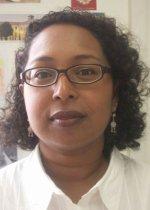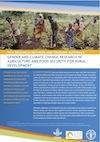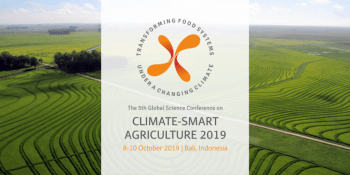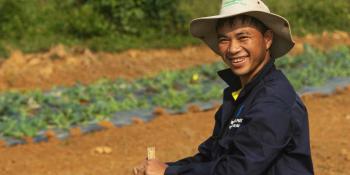On gender, climate change, and food security

 In an interview with Moushumi Chaudhury, we learn about the importance of research in the area of gender and climate change. Moushumi is a CCAFS Science Officer working on linking knowledge with action, with a special focus on gender and climate change. Ms Chaudhury also focuses on partnership and communication.
In an interview with Moushumi Chaudhury, we learn about the importance of research in the area of gender and climate change. Moushumi is a CCAFS Science Officer working on linking knowledge with action, with a special focus on gender and climate change. Ms Chaudhury also focuses on partnership and communication.
What examples can you give about the differences in the division of labour between men and women farmers? How might climate change affect this situation?
Well, I can give you a few examples from research that has been done in each of the three regions where CCAFS is working.
In Tanzania, there’s a distinct division of labour between men and women regarding the collection of water. In over three-quarter of the households, women are responsible for getting water for cooking and other domestic uses. IPPC scenarios indicate that as many as 250 million people will face water scarcity as a result of climate change. So a decline in the availability of water may have a particularly pronounced impact on rural women in Tanzania. It may mean that they will need to walk farther and spend more time looking for water, giving them less time to grow food, earn money and care for the family. This will increase women’s burden of work.
Here’s another example. In Ghana, men and women farmers don’t grow the same crops. Men tend to grow cashew, cocoa, coconut, okra, onion and sugarcane, while women grow eggplant, beans and tend the banana plants. In Ghana, certain agroforestry practices, particularly the cultivation of acacia trees with farm crops, has been shown to be a potentially effective adaptive strategy for climate change. Acacia trees are very resistant to wide fluctuations in rainfall. What has been found is that acacia trees are commonly grown on men’s fields, which leaves women’s crops more vulnerable to these fluctuations. So in this case, women may have not have the same options for coping with climate change.
In some areas of India, lower rainfall patterns have led to lower yields for farmers. In lower caste households, many men have chosen to abandon their fields to look for work in larger cities. For lower caste families, this migration is one of the main adaptive strategies for coping with changes in climate. But it is often not an option for women. Lower caste women in particular will look for local wage labour. What will be the consequences for the women left behind who are responsible for growing food for their family and providing immediate income? The research that FAO has done in this area is particularly important in that it highlights the fact that adaptive strategies are shaped by a combination of many factors, such as class and caste, in addition to gender.
Why is research in the area important? What are some of the specific areas you are looking into?
Marginalized people, both men and women, have few options for coping with climate change. Our goal is to carry out research that can improve the adaptive capacity of men and women in vulnerable communities. To do this, it’s important to understand the different roles and responsibilities of men and women, how they are changing and what interventions can boost their adaptive capacity.
We’re preparing training documents to help researchers better understand gender roles and how they may affect a community’s capacity to adapt to climate change. As part of our research, we’re testing a variety of interventions in which adaptive strategies are introduced in farming communities. We want to build up our knowledge so that we can make informed decisions about the outcomes of specific interventions based on our understanding of the context in which they are applied.
Our research concentrates on three major themes. One theme deals with seasonal forecasts. Right now, seasonal forecasts apply to a very broad geographic range. We want to downscale forecasts, so that they are more specific to particular areas and more useful to farming communities. But we also know that there are differences in the way men and women use the information provided by these forecasts. So we are conducting research on the seasonal forecast information that is currently available to farmers and investigating whether it is useful to men and women. Does the information make a difference in their lives? What type of information do men and women farmers want?
Another theme of our research is climate analogues. The use of climate analogues allows us to identify locales where the current conditions are likely to match the expected conditions in other locales under climate change scenarios. We want to make these climate analogues useful to men and women farmers, so we are investigating to what extent are farmers are able to visit communities that have adapted to similar conditions. What are men and women’s their capacity to learn adaptive strategies from their neighbours? What are the opportunities for farmer-to-farmer exchanges?
Finally, we want to identify the types of environments that are the most conducive to the uptake of adaptive strategies. For example, in East Africa there are quite a number of carbon projects under way. We would like to identify the conditions that need to be in place for these projects and other climate change interventions to succeed. Research in this area involves analysing the institutional context as well as the environmental and geographical conditions in a given area. What we want to understand is what makes it possible for men and women to make the decision to undertake a new approach in their farming practices, such as using a new technology or planting a new crop.
After field testing and finalizing the training manual, what will be done to help ensure that the manual is widely adopted by researchers?
The field testing of the training materials will be done by national partners in Bangladesh, Ghana and Uganda. Once the training documents have been finalized, based on feedback from the national partners, they’ll be used by CCAFS scientists to conduct research in CCAFS sites. They will serve to mainstream gender into research and analyses on gender and climate change. The training documents use the same sampling strategies used in the CCAFS household baseline surveys and village level surveys. This will give us consistent information that can allow us to make valid comparisons between areas with different climates, geography and crops and carry out comparative analyses at global, regional and local levels. Because the 15 CGIAR centres are also part of CCAFS, we hope that the training materials developed will also be taken up by centres to support their research on gender and climate change. FAO will use the material in its work to develop gender-sensitive strategies to adapt to climate change. The national partners who have field tested the materials will also continue to use and promote the materials in their ongoing work.
For UNCCC COP17, we prepared a brief describing the training materials. We believe the materials will be useful not only to researchers but to organizations that are developing projects on climate change adaptation and mitigation, focusing on gender and other aspects of social differentiation.
The 17th United Nations Framework Convention on Climate Change (UNFCCC) Conference of the Parties (COP17) will be held in Durban, South Africa in November. What would you like to see come out of this conference?
The biggest thing I would like to see come out of COP17 is that agriculture is put on the negotiating table in full view. So far, people involved in the negotiations have been skirting around the issue of agriculture. It’s the elephant in the room that no one’s talking about. Everyone recognizes that agriculture is a very large contributor to GHG emissions, but the subject has been avoided because it is very sensitive issue. People are really reluctant to address issues related to agriculture and climate change because of concerns about food security and the economic impacts it might have on some countries. The CGIAR, the World Bank and FAO have been working to highlight the importance of agriculture in climate change, and there is some momentum that will hopefully continue at COP17.
I would also like to see the UNFCCC strike a greater balance between mitigation and adaptation. Of course, we need to address the causes of climate change, but we also need to recognize that millions of vulnerable people will be affected by climate change. These people need support to adapt to new conditions. We need to talk about doing things differently and adopt a new strategy based on a two-prong approach to addressing climate change; an approach that gives equal weight both mitigation and adaptation.
Are there certain issues that you think are not receiving enough attention in global efforts to address climate change in agriculture? What are the key messages would you like to see communicated?
Well, as is said about the COP17, I think we need to convey the message that we have to look at mitigation and adaptation equally. Much of the emphasis has been on mitigation, especially in industry but also in forestry, through the Reducing Emissions from Deforestation and Forest Degradation (REDD) initiatives. But we have to realize that adaptation and mitigation are two sides of the same coin. We need to really to promote ‘climate-smart agriculture’, which addresses both mitigation and adaptation without losing focus on the fundamental importance of food security.
Read more
| Marja-Liisa Tapio-Bistrom (FAO), Yianna Lambrou (FAO), Patti Kristjanson (CCAFS) December 2011 |
This story was originally published on the Mitigation of Climate Change in Agriculture (MICCA) Programme website.



